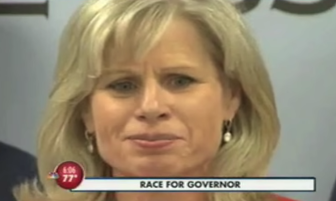38,000 TV Ads in Governor’s Race
And still rising, with percentage of negative ads higher than in nearly any state, study shows.
Like them or not — and most people don’t — television ads are a mainstay of modern political campaigns. They arguably matter more than debates, websites and media coverage.
A cynic might say that explains a lot.
But political ads do help define issues and provide useful information about candidates. In Wisconsin, they are central to the battle between Republican Gov. Scott Walker and Democratic challenger Mary Burke over the roughly 4 percent of the electorate that is still undecided.
Walker’s message is that he is taking Wisconsin forward while Burke would drag it backwards. Burke’s message is that Walker has done a lousy job and she can do better
The Walker and Burke campaigns have each released about a dozen ads since the Aug. 12 primary, according to the archive AdWatch on WisPolitics.com. Outside groups have generated about half as many.
The national nonprofit Center for Public Integrity is tracking how many ads ran and at what cost. The group’s State Ad Wars Tracker, updated weekly, tallies broadcast and national cable TV political ad buys — even the otherwise unreported “issue ads” that don’t expressly call for a candidate’s election or defeat. It only counts ads that have already aired.
Through Oct. 13, the tracker estimated, more than 38,000 ads had aired in the Wisconsin governor’s race, at a cost of $12.7 million. The Walker campaign spent $4.9 million on ads compared to Burke’s $4.2 million. Overall, Burke and her backers had a slight spending edge.
The leading outside group spender, at $2.1 million, has been the pro-Burke Greater Wisconsin Committee. The group, funded largely by labor unions, engages in express advocacy as well as issue ads. In the governor’s race, it’s run mainly the latter, like the one that ends, “Tell Gov. Walker to stop selling out Wisconsin farmers.”
Walker’s backers include the Republican Governors Association, which has booked more than $2 million in state ad time through its offshoot, Right Direction Wisconsin.
Modern ad campaigns are remarkably nimble. On Oct. 6, the national political group Emily’s List, which plans to spend $1.2 million on Burke’s behalf, launched an ad ripping Walker’s record on abortion. That same day Walker came out with his own ad striking a moderate tone, saying he wanted “to increase safety and to provide more information for a woman considering her options.”
Within days, the Burke campaign was airing an ad showing Walker affirming in a 2010 interview that he opposes abortion even in cases of rape and incest.
Walker and his allies, meanwhile, pounced on news that Burke’s jobs plan included material her hired consultant recycled from other candidates. This drew charges of “plagiarism” in ads from Walker’s campaign and Right Direction Wisconsin, which Burke sought to defuse in an ad of her own.
A national ad tracking project at Wesleyan University found that Wisconsin’s gubernatorial race had the nation’s smallest share of purely positive ads during a two-week period in September and more recently ranked among the top states for purely negative ones.
But University of Wisconsin-Madison journalism and mass communication professor Michael Wagner, an expert on political messaging, finds the silver lining. For one thing, he says, the ads in Wisconsin have not been as personal or harsh as those in other states.
Moreover, Wagner cites research showing that negative ads contain more policy information than positive ones. There are “perverse benefits” to these ads, he says, in terms of educating voters.
Wisconsin voters will have many such educational opportunities before the Nov. 4 election.
Bill Lueders is the Money and Politics Project director at the Wisconsin Center for Investigative Journalism (www.WisconsinWatch.org). The Center produces the project in partnership with MapLight.
The Center collaborates with Wisconsin Public Radio, Wisconsin Public Television, other news media and the UW-Madison School of Journalism and Mass Communication. All works created, published, posted or disseminated by the Center do not necessarily reflect the views or opinions of UW-Madison or any of its affiliates.
-
Wisconsin Lacks Clear System for Tracking Police Caught Lying
 May 9th, 2024 by Jacob Resneck
May 9th, 2024 by Jacob Resneck
-
Voters With Disabilities Demand Electronic Voting Option
 Apr 18th, 2024 by Alexander Shur
Apr 18th, 2024 by Alexander Shur
-
Few SNAP Recipients Reimbursed for Spoiled Food
 Apr 9th, 2024 by Addie Costello
Apr 9th, 2024 by Addie Costello























I continue to be amazed that people still own televisions 🙂 But of course, that makes me a snob, apparently.
Says the guy using some device to comment on the internet. That means you’re only a snob over the size of your display. Scribble this comment in the margins of a library book, then I’ll be impressed. 🙂
Use rabbit ears and a converter box.
Settings allow blocking any/all commercial broadcast stations.
For my taste, the multiple PBS stations include a variety of news from US, Europe & Asia but also an excellent stream of documentaries.
Classical & Jazz radio streams (on TV!) are limited, but are at least available.
I haven’t watched a political advert. for years.
Most ads are a wasteland. Especially political ads and squandering of finances. A better use would be donate all that money to benefit low wage workers, health care needs and college scholarships where the funds would really make a difference.
Thank goodness for recording ability with DVR and fast forwarding to pass over this voting season trash that is mostly fabrication, distortions and pollutes the media air waves.
That wasteland and trash supports the model that provides free broadcast television. Somebody has to buy up all the ad space. Look on the bright side, once the election is over, you get almost two full months of Christmas sale ads.
After the last few weeks of nonstop attack ads, I can’t wait for the Lexus “Hey Why Not Buy a Brand New $80,000 Car For Xmas?” ads.